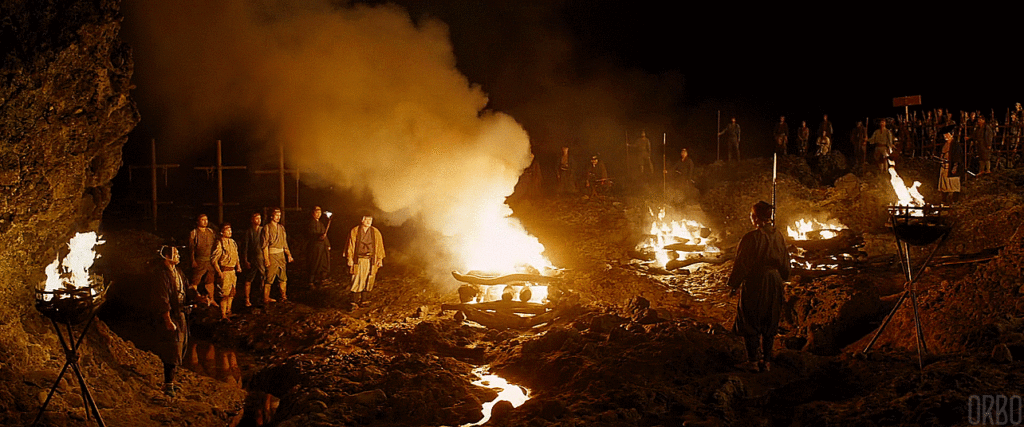Burying a witch must be performed under the same cautionary conditions as burying a vampire — that is, going to extreme lengths to ensure they never come back again to haunt the town that put them underground in the first place. While vampires were buried with stakes to the heart, garlic around the neck, stones in their mouth to keep their teeth away from any fleshy necks — as it turns out, many of the same methods also applied to burying witches of old, not including the traditional open fire burial.

-
Face Down
Historically, it was thought that a person’s soul escaped through their mouth upon death. By being buried face down, a witch’s soul would have no choice but to remain in their body, unable to return to the surface to begin her centuries of haunting and ruining crops. Should she awaken while still underground, by being face down, surely she’d have nowhere to go but deeper into the dirt while she thought she climbed for the surface.
Secondly, many cultures considered being buried face down as purposefully bringing shame upon the person, and was used for more than those declared witches. And it was widespread; the practice could be commonly found occurring in Peru, to Sweden, to South Korea.
Illness, suicide, criminal activity, prisoners of war, or anything else considered “negative” in life that likely led to the person’s untimely death, constituted a face-down burial. And what’s more negative, more worthy of a shameful, unconsecrated burial than being declared and buried as a witch?
-
Nailed Down
Similar to their vampire cousins, witches were also occasionally found nailed down into their coffins, likely with the same intention of keeping them there until there was no soul to return to wreak havoc upon the townspeople. Nails were used in both the jawbone and in her clothes, with no other shroud or coffin to speak of in the shallow grave.

According to archaeologist Alfonso Forgione on the discovery of a “witch graveyard” in Italy: “This indicates to me that it was an attempt to make sure the woman, even though she was dead, did not rise from the dead and unnerve the locals who were no doubt convinced she was a witch with evil powers.”
-
Stones Between Teeth
As mentioned previously, it wasn’t outrageous to exhume skeletons with stones, bricks, or some other hard object crammed between their teeth. According to The Atlantic, “The approach of ramming something firmly in a corpse’s open jaw has been observed both in 8th-century Irish ‘zombie burials’ and the grave of the ‘Vampire of Venice,’ a 16th-century skeleton disinterred from a plague cemetery with a large sized brick wedged between the teeth.”

While the belief that corpses bearing bricks in their mouths were actually, purposefully buried that way is a contended idea within the archaeological community, the thought alone is enough to send chills down your spine. For a community to be so frightened of a person, a creature, a vampire, a witch, that they felt compelled to insert something hard between their teeth to keep the corpse from rising again and taking bites out of everyone, it’s easy to imagine the level of fear and belief those people lived with on the daily.
-
Crushed Under Boulders, Stone Slabs
Another method of making sure a disobedient witch remained in her grave was to either cover her tomb with a stone slab, or to simply drop a boulder over her corpse and weigh her down. The idea was similar to that of nailing the witch down, though perhaps a little less dramatic. The whole point was only to keep her underground until the world stopped turning. Some good that did, as now every modern archaeologist who stumbles upon a stone tomb is likely to open it and set her free.

-
Above Ground Burials
According to Elaine G. Breslaw in her book Witches of the Atlantic World: An Historical Reader and Primary Sourcebook, another common practice for ridding of a witch’s body was for them to be placed in a shallow, yet still above-ground grave, seeing as they were never meant to again become one with the earth, a creation of God.
Found mainly in Barbados, Breslaw goes on to describe the common methods of burial:
The ‘ordinary’ burial involves digging a new grave in the form of a ‘bell-shaped chamber,’ while the other two methods are reserved for community members ‘who are considered dangerous.’ In one method, a ‘trench grave’ is dug in an area removed from where normal people have been buried and without the usual funeral ceremonies. Trench grave burials can include victims of epidemics, suicides, those convicted of various crimes, and witches; the body of a witch, in fact, ‘is simply disposed of as quickly as possible in an old grave, which is never again reopened.’

Another burial for ‘dangerous’ persons involves the ‘building of a mound above the corpse.’ Although this method is mainly used for infants who are not yet considered fully human, [it is implied] that it can be also used for suicides and witches. [It’s explained] that the principle governing the mound burial ‘appears to be the avoidance of burial within the earth itself’ and ‘one way of minimizing contact with the earth is to build the grave above ground.’ Thus, an ‘evil-doer’ is ‘buried under a pile of earth,’ but even persons buried in trench graves are considered to have ‘sinned against the Earth shrine’; witches fall well within this category as witchcraft is considered ‘an offense against the Earth.’
Considering all of these methods to guarantee a witch remains where she’s laid, it makes sense that witches have gone down in history as being such vile, repulsive, evil things. For those townspeople living lives surrounded by folk magic, threats of the devil, and even more threats of sin, it’s no surprise that they would go to such great lengths to ensure their souls remain whole and good in the eyes of God, away from those seen as sinners — more specifically, witches, and the witch’s influence even in death.

In learning this, I can’t stop thinking about the mound of dirt my friend from high school had in her backyard. She always told me, “my parents just wanted it when they built the house,” but now knowing what I know, I’m a little more suspicious.
Needless to say, the next time you move houses, there are probably a few things to keep your eyes peeled for, other than just making sure all of the electrical sockets and stove heads work: dirt mounds in your backyard, ambiguously placed boulders or stone slabs, old bricks with teeth marks. You must always be diligent. But, if you’re still suspicious, just take a look back at this other, helpful Witchy Wednesday post that’ll offer some ideas for the next steps to take.
Want to read more? Check out these sites!
The Stories Behind 8 “Witch” Graves
Witches of the Atlantic World On Amazon
Kelsey graduated from Boise State University with a BA in Visual Arts, and is currently working as a freelance writer, while doodling anime on the side with one hand and petting cats with the other.

